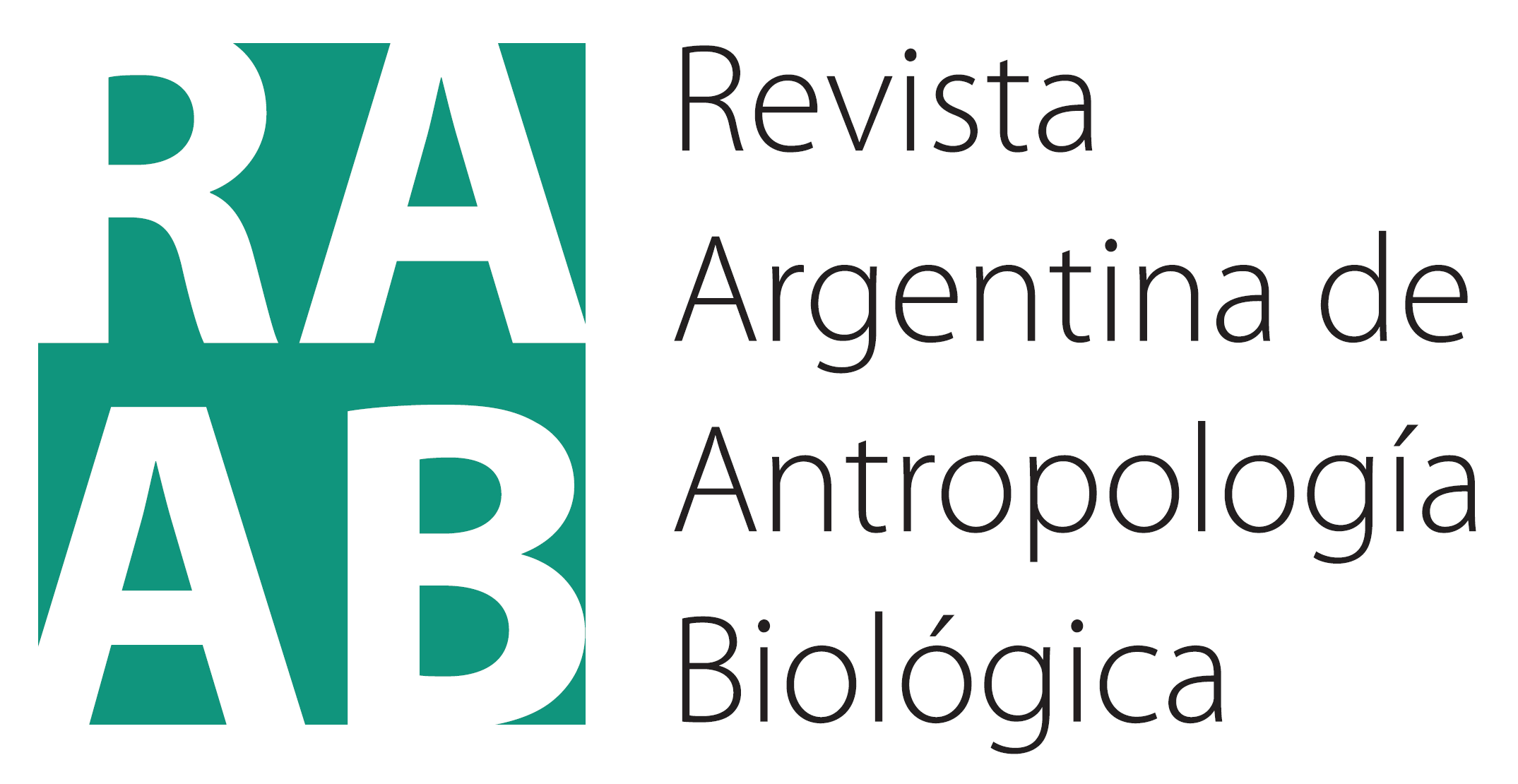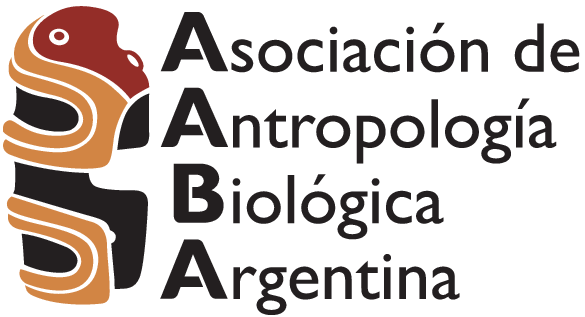First approaches to infectious diseases in bone tissue from Late Holocene populations of central western Argentina
DOI:
https://doi.org/10.24215/18536387e076Keywords:
human remains, paleopathology, Mendoza, Córdoba, epidemiological transitionsAbstract
Infectious diseases have been one of the main causes of death in prehistoric populations. Their study reveals their impact on population dynamics and enables research on patterns of adaptation to the emergence of new pathogens and their mutations. The aim of this work is to present a first approach to the analysis of infectious diseases in bioarchaeological remains from the Late Holocene (from ca. 4200 cal years BP to the present) in high altitude and lowland environments of Mendoza and Córdoba (Argentina). The groups that inhabited these areas present differences regarding their social organization, but they share similarities in lifestyle and subsistence strategies, based on hunting-gathering at the beginning of the period, and the introduction of horticulture towards the end of the Holocene. Paleopathological analysis of 75 adult individuals of both sexes was carried out. Macroscopic observation and systemic recording of bone lesions were performed. Frequencies were calculated by sex, age, chronological (pre and post 1000/1200 years BP), and environmental criteria (Highlands/ Lowlands and Plains/Mountains). Forty-eight percent of the total sample presented lesions possibly associated with infectious pathologies; 46% were from Mendoza and 58.3% from Córdoba. Higher prevalences are observed for Mendoza at the beginning of the Late Holocene and for Córdoba at the end of the period. Regarding environmental aspects, the groups that inhabited the Sierras area in Córdoba and the Mendoza Plain registered higher prevalences. These results are discussed in relation to the epidemiological transitions model.
Downloads
Metrics
References
Appleby, J., Thomas, R. y Buikstra, J. E. (2015). Increasing confidence in paleopathological diagnosis -Application of the Istanbul terminological framework. International Journal of Paleopathology, 8, 19-21. https://doi.org/10.1016/j.ijpp.2014.07.003
Armelagos, G. J., Barnes, K. C. y Lin, J. (1996). Disease in human evolution: The re-emergence of infectious disease in the third epidemiological transition. Anthro. Notes: Museum of Natural History Publication for Educators, 18(3), 1-7. http://hdl.handle.net/10088/22354
Armelagos, G. J., Brown, P. J. y Turner, B. (2005). Evolutionary, historical and political economic perspectives on health and disease. Social Science & Medicine, 61(4), 755-765. https://doi.org/10.1016/j.socscimed.2004.08.066
Aufderheide, A. y Rodríguez-Martín, C. (1998). The Cambridge encyclopedia of human palaeopathology. Cambridge University Press.
Bárcena, J. R. (2001). Prehistoria del Centro-Oeste Argentino. En E. E. Berberián y A. Nielsen (Eds.), Separata de Historia Argentina Prehispánica II (pp. 561-614). Editorial Brujas.
Barret, R., Kuzawa, C. W., McDade, T. y Armelagos, G. J. (1998). Emerging and re-emerging infectious diseases: The third epidemiologic transition. Annual Review of Anthropology, 27, 247-271. https://doi.org/10.1146/annurev.anthro.27.1.247
Bass, W. M. (1995). Human osteology. A laboratory and field manual. Missouri Archaeological Society.
Buikstra, J. E. (Ed.). (2019). Ortner’s identification of pathological conditions in human skeletal remains (3a ed.). Academic Press. https://doi.org/10.1016/C2011-0-06880-1
Buikstra, J. E. y Ubelaker, D. H. (1994). Standards for data collection from human skeletal remains. Arkansas Archaeological Survey Research Series No. 44.
Buikstra, J. E., Cook, D. C. y Bolhofner, K. L. (2017). Introduction: scientific rigor in paleopathology. International Journal of Paleopathology, 19, 80-87. https://doi.org/10.1016/j.ijpp.2017.08.005
Buzon, M. (2012). The bioarchaeological approach to paleopathology. En A. Grauer (Ed.), A companion to paleopathology. (pp. 59-75). Wiley-Blackwell. https://doi.org/10.1002/9781444345940.ch4
Cohen, M. N. y Armelagos, G. J. (1984). Paleopathology at the origins of agriculture. Academic Press.
Cohen, M. N. y Crane-Kramer, G. M. M. (Eds.). (2007). Ancient health: Skeletal indicators of agricultural and economic intensification. University Press of Florida.
Cortegoso, V. (2006). Comunidades agrícolas en el Valle de Potrerillos (NO de Mendoza) durante el Holoceno tardío: organización de la tecnología y vivienda. Intersecciones en Antropología, 7, 77-94.
Cueto, A. O., Romano, A., M. y Sacchero, P. (1994). Historia de Mendoza. Desde los primitivos habitantes hasta nuestros días. Fascículo 1. (pp. 1-31). Diario Los Andes.
Da Peña Aldao, G., Novellino, P. S. y Frigolé, C. (2016). Caracterización del Túmulo II (Uspallata, Mendoza): actualización del análisis del contexto funerario. Comechingonia. Revista de Arqueología, 20(1), 21-50. https://doi.org/10.37603/2250.7728.v20.n1.17937
DeWitte, S. N. (2014). Differential survival among individuals with active and healed periosteal new bone formation. International Journal of Paleopathology, 7, 38-44. https://doi.org/10.1016/j.ijpp.2014.06.001
DeWitte, S. N. y Stojanowski, C. M. (2015). The osteological paradox 20 years later: past perspectives, future directions. Journal of Archaeological Research, 23(4), 397-450.
Durán, V. A., Gasco, A. V., Paiva, J., Zonana, I. y Barberena, R. (2020). El aprovechamiento de camélidos y ambientes de altura en sociedades agropastoriles prehispánicas del Noroeste de Mendoza (Argentina). Relaciones de la Sociedad Argentina de Antropología, XLV(2), 271-296.
Durán, V. A., Novellino, P. S., Menéndez, L. P., Gasco, A. V., Marsh, E J., Barberena, R. y Frigolé, C. (2018). Barrio Ramos I. Prácticas funerarias en el inicio del período de dominación inca del valle de Uspallata (Mendoza, Argentina). Relaciones de la Sociedad Argentina de Antropología, XLIII(1), 55-86.
Fabra, M., Alderete, A. P. y Ferreyra, M. E. S. (2019). Investigaciones bioarqueológicas en costa este de la Laguna del Plata e Isla El Mistolar (Laguna Mar Chiquita, Córdoba), todo en papel. Voces del Ayer, 6, 9-45. http://hdl.handle.net/11336/126160
Fabra, M. y González, C. V. (2019). Oral health and diet in populations of Central Argentina during the Late Holocene: Bioarchaeological and isotopic evidence. Latin American Antiquity, 30(4), 818-835. https://doi.org/10.1017/laq.2019.69
Fabra, M., González, C. V. y Salega, M.S. (2012). Modos de vida e historia biológica de poblaciones de las sierras y las llanuras de Córdoba (Argentina): Aproximaciones desde el registro bioarqueológico. Revista Argentina de Antropología Biológica, 14(2), 87-104.
Fabra, M., Nores, R., Salega, M. S. y González, C. V. (2014). Entre las sierras y el Mar: investigaciones bioarqueológicas en el noroeste de la región pampeana (costa sur de la Laguna Mar Chiquita, Córdoba, Argentina). En L. Luna, J. A. Suby y C. Aranda (Eds.), Avances recientes en la bioarqueología sudamericana (pp. 205-231). Grupo de Investigación en Bioarqueología. http://hdl.handle.net/11086/29814
Flensborg, G. (2016). Health and disease of hunter-gatherer groups from the eastern Pampa-Patagonia transition (Argentina) during the Late Holocene. Anthropological Science, 124(1), 29-44. https://doi.org/10.1537/ase.151001
García Guraieb, S. (2006). Salud y enfermedad en cazadores-recolectores del Holoceno tardío en la Cuenca del Lago Salitroso (Santa Cruz). Intersecciones en Antropología, 7, 37-48.
Gasco, A. V., Marsh, E. J., Frigolé, C., Castro, S., Privitera, C., Moyano, R. y Yebra, L. (2011). Actividades domésticas durante los siglos III-VIII d. C. en el valle de Potrerillos (San Ignacio-Mendoza). Un acercamiento desde la osteometría y la tecnología cerámica y lítica. Revista del Museo de Antropología, 4(1), 145-160. https://doi.org/10.31048/1852.4826.v4.n1.5476
Gil, A., Villalba, R., Ugan, A., Cortegoso, V., Neme, G., Michieli, C. T., Novellino, P. S. y Duran, V. (2014). Isotopic evidence on human bone for declining maize consumption during the Little Ice Age in central western Argentina. Journal of Archaeological Science, 49, 213-227. http://dx.doi.org/10.1016/j.jas.2014.05.009
González, C. V. y Fabra, M. (2018). Desgaste dental y hábitos dietarios en poblaciones arqueológicas del Centro de Argentina. Arqueología, 24(2), 133-159. https://doi.org/10.34096/arqueologia.t24.n2.5004
González, M. (2013). Procesos de formación y efectos tafonómicos en entierros humanos: el caso del sitio Paso Alsina I en Patagonia Nororiental Argentina. Magallania, 41(1), 133-154.
Gordillo, S. y Fabra, M. (2018). Cuentas malacológicas asociadas a restos óseos humanos en el Holoceno tardío de la región central de Argentina. Revista del Museo de Antropología, 11(2), 49-58. https://doi.org/10.31048/1852.4826.v11.n2.19461
Hammer, Ø., Harper, D. A. T. y Ryan, P. D. (2001). PAST: Paleontological statistics software package for education and data analysis. Palaeontologia Electronica, 4(1), 1-9. http://palaeo-electronica.org/2001_1/past/issue1_01.htm
Harper, K. y Armelagos, G. J. (2010). The changing disease-scape in the third epidemiological transition. International Journal of Environmental Research and Public Health, 7(2), 675-697. https://doi.org/10.3390/ijerph7020675
Iriondo, M. H. (2010). Geología del Cuaternario en Argentina. Museo Provincial de Ciencias Naturales Florentino Ameghino.
Izeta, A. D. y Aguilar, L. H. (2022). Estandarización de categorías temporales utilizadas en la arqueología del Centro de Argentina en los últimos 140 años. Nuevos usos y viejos datos. Chungara Revista de Antropología Chilena, 54(4), 659-675. http://dx.doi.org/10.4067/S0717-73562022005001301
Klaus, H. D. y Lynnerup, N. (2019). Abnormal bone: considerations for documentation, disease process identification and differential diagnosis. En J. E. Buikstra (Ed.), Ortner’s identification of pathological conditions in human skeletal remains (pp. 59-89). Elsevier. https://doi.org/10.1016/b978-0-12-809738-0.00005-3
Lagiglia, H. (1968). Secuencias culturales del Centro-Oeste Argentino: Valles del Atuel y Diamante. Revista Científica de Investigaciones, I(4), 159-174.
Laguens, A. (1999). Arqueología del contacto hispanoindígena. Un estudio de cambios y continuidades en las Sierras Centrales de Argentina. BAR International Series 801. Archaeopress.
Laguens, A. G. y Bonnin, M. (2009). Sociedades indígenas de las Sierras Centrales: Arqueología de Córdoba y San Luis. Editorial Universidad Nacional de Córdoba.
Laguens, A. G., Fabra, M., Dos Santos, G. M. y Demarchi, D. A. (2009). Palaeodietary inferences based on isotopic data for pre-Hispanic populations of the Central Mountains of Argentina. International Journal of Osteoarchaeology, 19(2), 237-249. https://doi.org/10.1002/oa.1064
Larsen, C. S. (2006). The agricultural revolution as environmental catastrophe: Implications for health and lifestyle in the Holocene. Quaternary International, 150(1), 12-20. https://doi.org/10.1016/j.quaint.2006.01.004
Larsen, C. S. (2015). Introduction. En C. S. Larsen (Ed.), Bioarchaeology. Interpreting behavior from the human skeleton (pp. 1-6). Cambridge University Press.
Llano, C. y Cortegoso, V. (2015). Valoración de las estrategias de intensificación en el registro vegetal del sitio Alero Los Conitos, Mendoza, Argentina. Comechingonia. Revista de Arqueología, 19(2), 185-202. https://doi.org/10.37603/2250.7728.v19.n2.18137
Marsh, E. J., Kidd, R., Ogburn, D. y Duran, V. (2017). Dating the expansion of the Inca Empire: Bayesian models from Ecuador and Argentina. Radiocarbon, 59(1), 117-140. https://doi.org/10.1017/RDC.2016.118
Medina, M. E., Pastor, S. y Berberián, E. E. (2014). ‘‘Es gente fazil de moverse de una parte a otra”. Diversidad en las estrategias de subsistencia y movilidad prehispánicas tardías (Sierras de Córdoba, Argentina). Complutum, 25(1), 73-88. https://doi.org/10.5209/rev_CMPL.2014.v25.n1.45356
Menéndez, L. P., Novellino, P. S., D’Addona, L. A., Béguelin, M., Brachetta Aporta, N. y Bernal, V. (2014). El registro bioarqueológico y la incorporación de las prácticas agrícolas en el Centro-Norte de Mendoza. En V. Cortegoso, V. A. Durán y A. V. Gasco (Eds.), Arqueología de ambientes de altura de Mendoza y San Juan (Argentina) (pp. 101-125). EDIUNC.
Miranda de Zela, P. y Fuchs, M. L. (2019). Deformación artificial del cráneo y patologías metabólico-sistémicas e infecciosas en la población tardía de la Puna de Jujuy, Argentina (1000-1450 D.C.). Cuadernos de la Facultad de Humanidades y Ciencias Sociales, Universidad Nacional de Jujuy, 0(56), 195-226.
Novellino, P. S., Brachetta Aporta, N., D’Addona, L. A., Estrella, D., Bernal, V., Devincenzi, S. M., Cortegoso, V. y Durán, V. A. A. (2013). Sitios de entierro de la localidad arqueológica Barrancas, Maipú (Mendoza, Argentina). Intersecciones en Antropología, 14, 271-277.
Novellino, P. S., Da Peña Aldao, G., Guevara, D. y Suby, J. A. (2022). Osteoartrosis en columna vertebral de antiguos pobladores del Centro-Norte de Mendoza durante el Holoceno tardío. Chungara Revista de Antropología Chilena, 54(2), 309-324. http://dx.doi.org/10.4067/S0717-73562022005000901
Novellino, P. S., Da Peña Aldao, G., Pandiani, C. D. y Suby, J. A. (2018). Análisis de lesiones osteoarticulares apendiculares en restos humanos del Centro-Norte de Mendoza. Anales de Arqueología y Etnología, 73(2), 171-188.
Novellino, P. S., Durán, V. A. y Prieto Olavarría, C. (2003). Cápiz Alto: aspectos bioarqueológicos y arqueológicos del cementerio indígena de época post-contacto (provincia de Mendoza, Argentina). Paleopatología, 1, 1-16.
Novellino, P. S., Menéndez, L. P. y Bernal, V. (2014). Avances en el conocimiento bioarqueológico de las poblaciones humanas del Centro-Norte de Mendoza. En V. Cortegoso, V. A. Durán y A. V. Gasco (Eds.), Arqueología de ambientes de altura de Mendoza y San Juan (Argentina) (pp. 43-55). EDIUNC.
Omran, A.R. (1971). The epidemiologic transition: A theory of the epidemiology of population change. Millbank Memorial Fund Quarterly, 49, 509-538.
Office of the High Commissioner for Human Rights. (2022 edition). Istanbul Protocol: Manual on the effective investigation and documentation of torture and other cruel, inhuman or degrading treatment or punishment. https://www.ohchr.org/en/publications/policy-and-methodologicalpublications/istanbul-protocol-manual-effective-0
Ortner, D. J. (2003). Identification of pathological conditions in human skeletal remains (2ª ed.). Academic Press.
Pandiani, C. D., Santos, A. L. y Suby, J. A. (2021). Procesos infecciosos en cazadores-recolectores de Patagonia Austral: Evidencias en restos óseos del Holoceno medio y tardío (ca. 5200-100 años AP). Latin American Antiquity, 33(2), 376-394. https://doi.org/10.1017/laq.2021.64
Pandiani, C. D., Suby, J. A. y Novellino, P. S. (2018). Lesiones periapicales y su relación con las prácticas de subsistencia en individuos del Centro-Norte de Mendoza durante el Holoceno Tardío. Revista del Museo de Antropología, 11(2), 109-122. https://doi.org/10.31048/1852.4826.v11.n2.20920
Ramos van Raap, M. A. (2018). Paleopatología en poblaciones prehispánicas del sur del Noreste Argentino. [Tesis doctoral, Facultad de Ciencias Naturales y Museo, Universidad Nacional de La Plata]. https://sedici.unlp.edu.ar/handle/10915/79688
Roberts, C. A. (2019). Infectious disease: Introduction, periostosis, periostitis, osteomyelitis and septic arthritis. En J. E. Buikstra (Ed.), Ortner’s identification of pathological conditions (pp. 285-319). Academic Press. https://doi.org/10.1016/B978-0-12-809738-0.00010-7
Roberts, C. A. y Buikstra, J. E. (2019). Bacterial infections. En J. E. Buikstra (Ed.), Ortner’s identification of pathological conditions (pp. 312-439). Academic Press. https://doi.org/10.1016/B978-0-12-809738-0.00011-9
Roberts, C. A. (2018). Guidance on recording palaeopathology (abnormal variation). En P. Mitchell, y M. Brickley (Eds.), Updated guidelines to the standards for recording human remains (2ª ed.) (pp. 44-47). CIfA and BABAO.
Roberts, C. A. y Manchester, K. (2012). The study of palaeopathology. En C. A. Roberts y K. Manchester (Eds.), The archaeology of disease (pp. 23-70). The History Press.
Rusconi, C. (1962). Poblaciones pre y post hispánicas de Mendoza. Volumen III Arqueología. Imprenta Oficial, Mendoza.
Salega, M. S. y Fabra, M. (2017). Variaciones del terreno y cambios entesiales en poblaciones prehispánicas de Córdoba (Argentina). Revista del Museo de Antropología, 10(2), 131-136. https://doi.org/10.31048/1852.4826.v10.n2.16820
Santosa, A., Wall, S., Fottrell, E., Högberg, U. y Byass, P. (2014). The development and experience of epidemiological transition theory over four decades: A systematic review. Global Health Action, 7(1), 23574. https://doi.org/10.3402/gha.v7.23574
Schaefer, M., Black, S. y Scheuer, L. (2009). Juvenile osteology: A laboratory field manual. Academic Press.
Schobinger, J. (1975). Prehistoria y protohistoria de la región cuyana. Museo de Ciencias Naturales y Antropológicas de Mendoza Juan Cornelio Moyano.
Suby, J. A. (2020). Paleopathological research in Southern Patagonia: An approach to understanding stress and disease in hunter-gatherer populations. Latin American Antiquity, 31(2), 392-408. https://doi.org/10.1017/laq.2020.5
Suby, J. A., Guevara, D., Zúñiga Thayer, R. y Novellino, P. S. (2022). Fracturas compresivas de cuerpos vertebrales: Análisis metodológicos e interpretativos en restos humanos del Holoceno tardío en el centro-norte de Mendoza, Argentina. Intersecciones en Antropología, 23(Especial 1), 125-136. https://doi.org/10.37176/iea.23.Especial1.2022.714
Tavarone, A. M., Colobig, M. de los M. y Fabra, M. (2020). Estudio de dieta en poblaciones arqueológicas del centro de Argentina a través del análisis de microrrestos vegetales e isótopos estables. Intersecciones en Antropología, 21(2), 213-228. https://doi.org/10.37176/iea.21.2.2020.556
Tavarone, A. M., González, C. V., Salega, M. S., Bellis, J., Benedetti, F., Ramírez, D., Loupias, L. y Fabra, M. (2016). Análisis bioarqueológico de restos humanos recuperados en el sitio La Para 1387/15 (Departamento Río Primero, Córdoba). Memorias del Pueblo Digital: Revista del Museo Histórico Municipal “La Para”, 3(3), 5-21. http://hdl.handle.net/11336/62812
Walker, M. J. C., Berkelhammer, M, Björck, S., Cwynar, L. C., Fisher, D. A., Long, A. J., Lowe, J. J., Newnham, R. M., Rasmussen, S. O. y Weiss, H. (2012). Formal subdivision of the Holocene Series/Epoch: a discussion paper by a Working Group of INTIMATE (Integration of ice‐core, marine and terrestrial records) and the Subcommission on Quaternary Stratigraphy (International Commission on Stratigraphy). Journal of Quaternary Science, 27(7), 649-659.
Weston, D. (2012). Nonspecific infection in paleopathology: Interpreting periosteal reactions. En A. Grauer (Ed.), A companion to paleopathology (pp. 492-512). Wiley-Blackwell. https://doi.org/10.1002/9781444345940.ch27
Wood, J. W., Milner, G. R., Harpending, H. C. y Weiss, K. M., Cohen, M. N., Eisenberg, L. E., Hutchinson, D. L., Jankauskas, R., Cesnys, G., Cesnys, G., Katzenberg, M. A., Luckacs, J. R., McGrath, J. W., Abella, Roth, E., Ubelaker, D. H. y Wilkinson, R. G. (1992). The osteological paradox: Problems of inferring prehistoric health from skeletal samples [and comments and reply]. Current Anthropology, 33(4), 343-370.
Zuckerman, M., Harper, K. N., Barrett, R. y Armelagos, G. J. (2014). The evolution of disease: Anthropological perspectives on epidemiologic transition. Global Health Action, 7(1), 23303. https://doi.org/10.3402/gha.v7.23303
Downloads
Published
How to Cite
Issue
Section
License
Copyright (c) 2024 Gabriela Da Peña Aldao, Mariana Fabra, Paula NovellinoThe RAAB is a diamond-type open access journal. There are no charges for reading, sending or processing the work. Likewise, authors maintain copyright on their works as well as publication rights without restrictions.




























